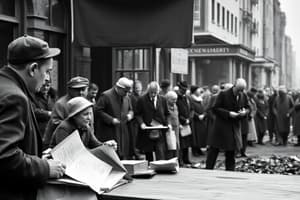Podcast
Questions and Answers
What was the peak unemployment rate during the Great Depression?
What was the peak unemployment rate during the Great Depression?
- 15%
- 25% (correct)
- 30%
- 20%
Which environmental disaster significantly impacted farmers during the Great Depression?
Which environmental disaster significantly impacted farmers during the Great Depression?
- Flooding
- Dust Bowl (correct)
- Wildfires
- Hurricanes
What discriminatory practice was instituted to limit African Americans' voting rights in the South?
What discriminatory practice was instituted to limit African Americans' voting rights in the South?
- Literacy test
- Poll tax (correct)
- Voter ID laws
- Grandfather clause
How did the Great Depression primarily affect minority groups compared to white Americans?
How did the Great Depression primarily affect minority groups compared to white Americans?
What led to the deportation of many Latino individuals during the Great Depression?
What led to the deportation of many Latino individuals during the Great Depression?
Flashcards are hidden until you start studying
Study Notes
The Great Depression Overview
- The Great Depression was the largest economic downturn in U.S. history, leading to widespread unemployment and societal challenges.
- Unemployment peaked at approximately 25%, severely impacting urban Americans who faced dire living conditions.
Urban Struggles
- Many unemployed individuals waited in soup kitchens and work lines for basic sustenance.
- Poverty led to increased crime and the establishment of shantytowns, known as "Hoovervilles."
Rural Hardships
- Farmers, particularly in the central U.S. and Midwest, suffered greatly due to over-farming, which contributed to soil depletion.
- The "Dust Bowl" emerged, resulting in massive dust storms that destroyed homes, equipment, and livestock, exacerbating the agricultural crisis.
Labor Strife
- Growing labor unrest characterized the era, with notable protests impacting the manufacturing sector and industrial workers.
Impact on Minority Groups
- Minority communities experienced intensified hardships; white Americans were affected, but minorities faced disproportionate challenges.
- Sharecroppers faced evictions as leases were brutally terminated, leading to increased instability among rural minorities.
Targeting of Latino and Asian Communities
- Latino and Asian individuals became scapegoats during the Depression, facing resentment and accusations of job theft from white Americans.
- Many Latinos were deported in large numbers despite some having U.S. citizenship.
African American Challenges
- African Americans encountered significant employment discrimination, with black workers often the first to be laid off in urban jobs.
- Southern African Americans were victims of racial violence and hostility, particularly from white Southerners.
Voting Suppression Tactics
- Poll taxes were implemented to disenfranchise Black voters and limit their participation in the electoral process, excluding them from jury service as well.
Long-term Effects
- The struggles faced by all Americans, especially marginalized groups, persisted until the U.S. engaged in World War II, which ultimately led to economic recovery.
Studying That Suits You
Use AI to generate personalized quizzes and flashcards to suit your learning preferences.




